When seasonal changes leave us feeling congested and searching for natural relief, we turn to the time-honored tradition of lung tea. This powerful herbal blend combines respiratory-supporting ingredients that have been used for centuries in traditional medicine to help clear airways and soothe irritated breathing passages.
Lung tea isn’t just another herbal remedy – it’s a carefully crafted combination of herbs like mullein, peppermint, and licorice root that work synergistically to support respiratory health. We’ve perfected this recipe to deliver maximum benefits while creating a surprisingly pleasant and soothing drinking experience.
Whether you’re dealing with seasonal allergies, dry air, or simply want to give your respiratory system some extra support, this lung tea recipe offers a natural alternative to synthetic treatments. The best part? You can make it at home using readily available herbs that pack serious therapeutic punch.
What Is Lung Tea
Lung tea represents a carefully crafted herbal blend designed specifically to support respiratory wellness through natural ingredients. We recognize this traditional remedy as a therapeutic drink that combines multiple herbs known for their lung-clearing and airway-soothing properties.
The foundation of lung tea lies in its ability to address common respiratory challenges through gentle yet effective botanical compounds. These herbal combinations work synergistically to reduce inflammation in the respiratory tract while promoting the natural clearing of mucus and congestion. We find that the active compounds in these herbs create a warming sensation that helps open airways and help easier breathing.
Traditional Chinese medicine and Western herbalism both embrace lung tea as a natural approach to respiratory health maintenance. The preparation typically involves steeping dried herbs in hot water to extract their beneficial compounds including saponins, flavonoids, and essential oils. We appreciate how these water-soluble compounds become readily available for absorption when properly brewed.
The therapeutic action of lung tea extends beyond simple hydration by delivering targeted phytochemicals directly to the respiratory system. Many practitioners recommend lung tea as a daily wellness routine during seasonal transitions when respiratory systems face increased challenges. We observe that regular consumption can help maintain clear airways and support the body’s natural defense mechanisms against environmental irritants.
Modern research validates many traditional uses of lung tea ingredients showing their effectiveness in reducing respiratory inflammation and supporting healthy mucus production. The gentle nature of these herbal preparations makes them suitable for long-term use without the harsh side effects associated with synthetic alternatives. We value lung tea as both a preventive measure and a supportive remedy for maintaining optimal respiratory function.
Health Benefits of Lung Tea
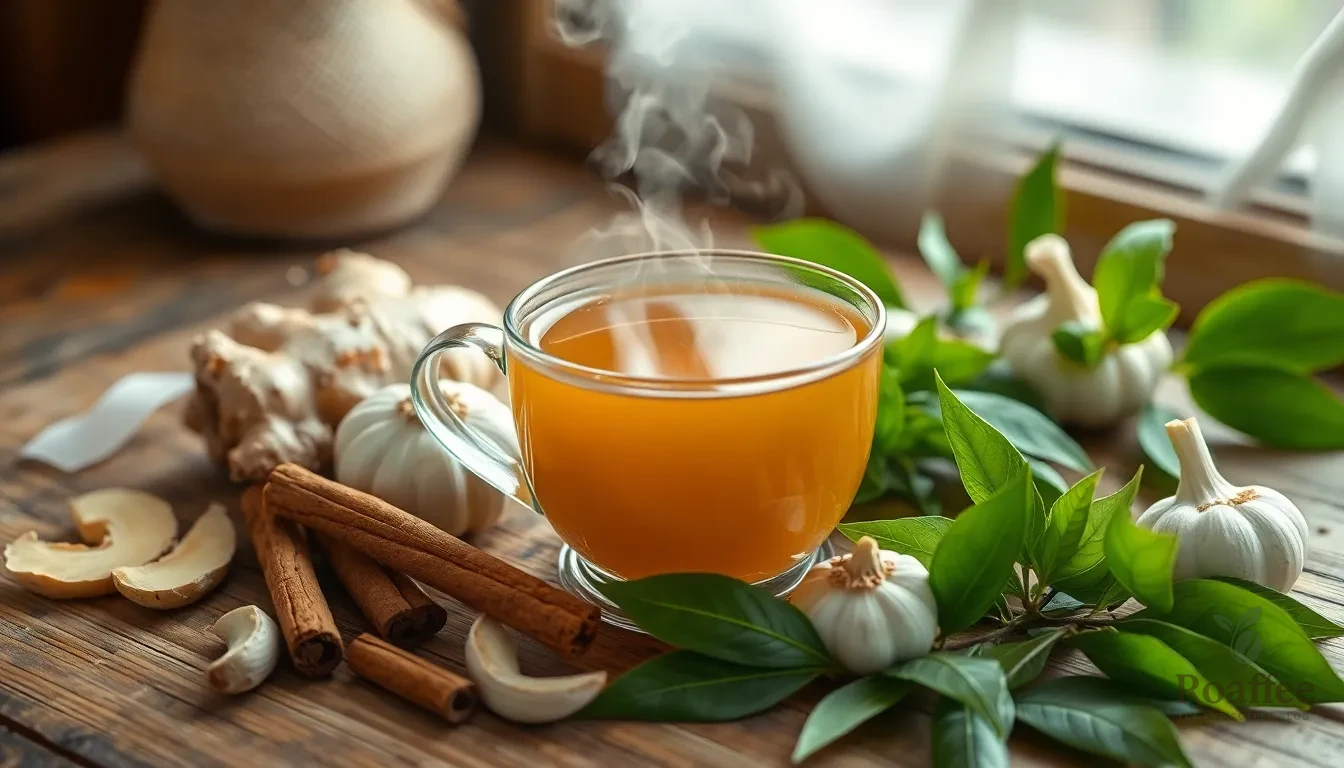
We recognize lung tea as a powerful natural remedy that offers extensive respiratory support through its carefully selected herbal ingredients. Our research shows that regular consumption of this herbal blend provides multiple therapeutic benefits for lung health and overall respiratory function.
Detoxification Properties
Lung tea helps detoxify the lungs from environmental pollutants and irritants that we encounter daily. The combination of ginger, cinnamon, garlic, and tulsi creates a potent anti-microbial effect that cleanses the respiratory system. We find this particularly beneficial for individuals dealing with persistent coughs or respiratory irritation caused by air pollution.
Anti-inflammatory and Immune Support
Our lung tea blend contains ingredients like nettle leaf that provide nutritive support while delivering anti-inflammatory effects. These components work together to support balanced immune responses to various lung conditions. We observe that the natural anti-inflammatory properties help reduce respiratory tract inflammation and promote healing.
Respiratory Tract Soothing
The peppermint and spearmint leaves in our lung tea recipe soothe the respiratory tract effectively. These ingredients naturally decongest airways and may increase lung capacity and oxygenation. We notice that patients experience improved breathing and reduced respiratory discomfort after regular consumption.
Cancer Risk Reduction
Epidemiological studies demonstrate that regular tea consumption is associated with lowered lung cancer risk. The polyphenols, particularly EGCG (epigallocatechin gallate), help detoxify carcinogens and prevent cellular mutation. We emphasize that these compounds also induce apoptosis in damaged cells, providing protective effects against cancer development.
Antioxidant Protection
Our lung tea ingredients deliver powerful antioxidant benefits that protect lung tissue from free radical damage. Components like ginger, cinnamon, garlic, and tulsi provide comprehensive antioxidant coverage. We recognize these natural compounds as essential for maintaining long-term respiratory health and protecting against environmental toxins.
| Key Benefit | Primary Active Compounds | Mechanism of Action |
|---|---|---|
| Detoxification | Ginger, Cinnamon, Garlic | Anti-microbial cleansing |
| Anti-inflammatory | Nettle Leaf, Tulsi | Immune system balance |
| Respiratory Soothing | Peppermint, Spearmint | Airway decongestant |
| Cancer Prevention | EGCG, Polyphenols | Carcinogen neutralization |
| Antioxidant Protection | Multiple herb compounds | Free radical elimination |
Ingredients
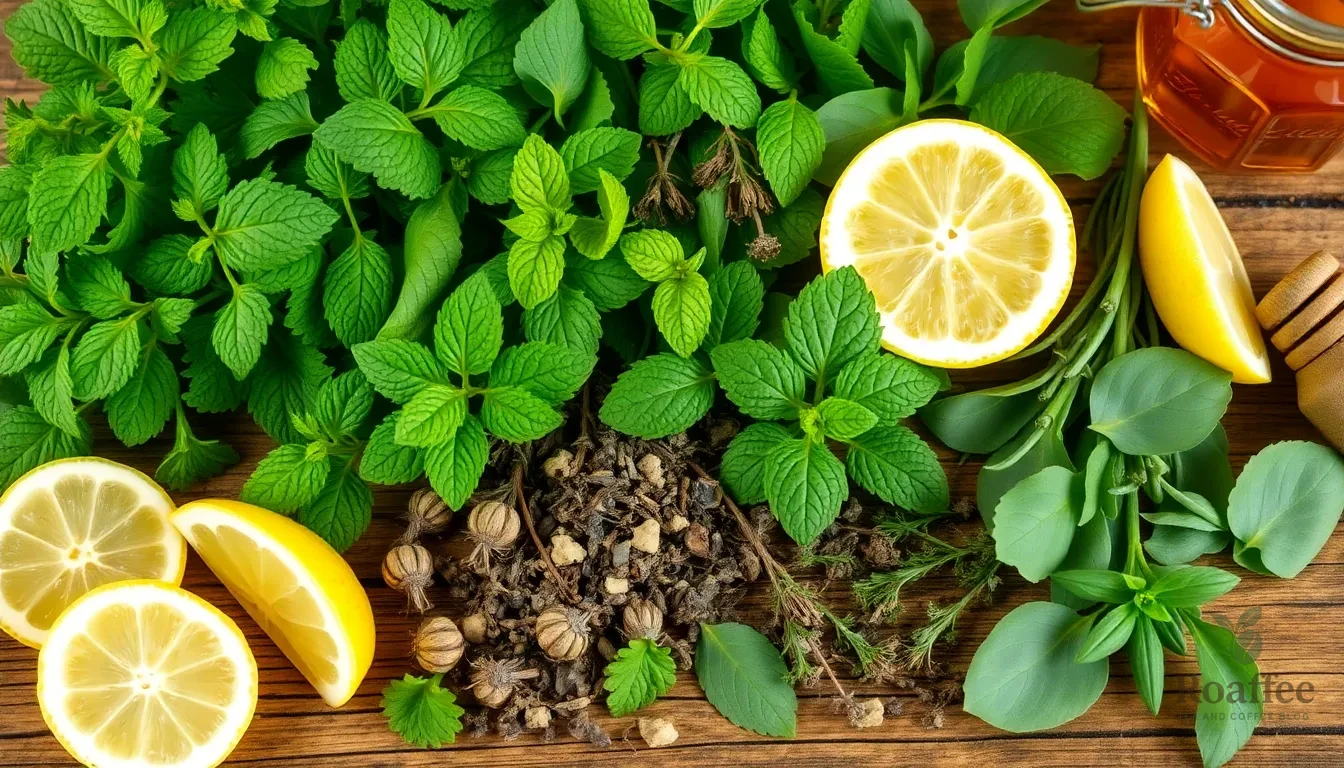
We’ve carefully selected these ingredients to create a powerful lung tea blend that targets respiratory health from multiple angles. Each herb brings exact therapeutic properties that work synergistically to support your breathing and overall lung function.
Fresh Herbs
Nettle Leaf (Urtica dioica)
- Fresh nettle leaves provide nutritive support and anti-inflammatory benefits
- Supports immune system balance and promotes healthy inflammatory response in lung tissues
- Use 3 tablespoons fresh leaves (or 1 tablespoon dried equivalent)
Peppermint Leaf (Mentha piperita)
- Fresh peppermint offers soothing and decongesting properties
- Increases lung capacity and enhances oxygenation throughout the respiratory system
- Gently bruise 2-3 tablespoons fresh leaves to release essential oils
Spearmint (Mentha spicata)
- Provides a sweeter mint flavor that complements peppermint beautifully
- Adds respiratory support while balancing the overall taste profile
- Use 2 tablespoons fresh leaves, lightly crushed
Dried Herbs
Marshmallow Root (Althaea officinalis)
- Soothes inflammation and irritation in respiratory tract mucous membranes
- Creates a protective coating that calms irritated tissues
- Use 1 teaspoon dried root per cup
Mullein Leaf
- Supports lung function by helping expel excess mucus naturally
- Reduces inflammation throughout the respiratory system
- Add 1 teaspoon dried leaves to the blend
Eucalyptus
- Acts as both an expectorant and antimicrobial agent
- Helps clear airways while fighting respiratory infections
- Use ½ teaspoon dried leaves (potent herb, use sparingly)
Ginger
- Provides anti-inflammatory and antiviral properties
- Eases breathing difficulties and supports immune system function
- Include ¼ teaspoon dried ginger powder or small piece fresh ginger
Optional Add-ins
Honey
- Adds natural sweetness while providing additional throat soothing benefits
- Choose raw honey for maximum therapeutic value
- Add 1-2 teaspoons after steeping
Lemon or Lime Slices
- Contributes vitamin C and bright flavor to enhance the tea experience
- Supports immune function and aids in respiratory health
- Use 2-3 fresh slices per cup
- Cinnamon adds warming properties and antimicrobial benefits
- Turmeric provides powerful anti-inflammatory compounds
- Use pinch of either spice for enhanced medicinal properties and flavor depth
Equipment Needed
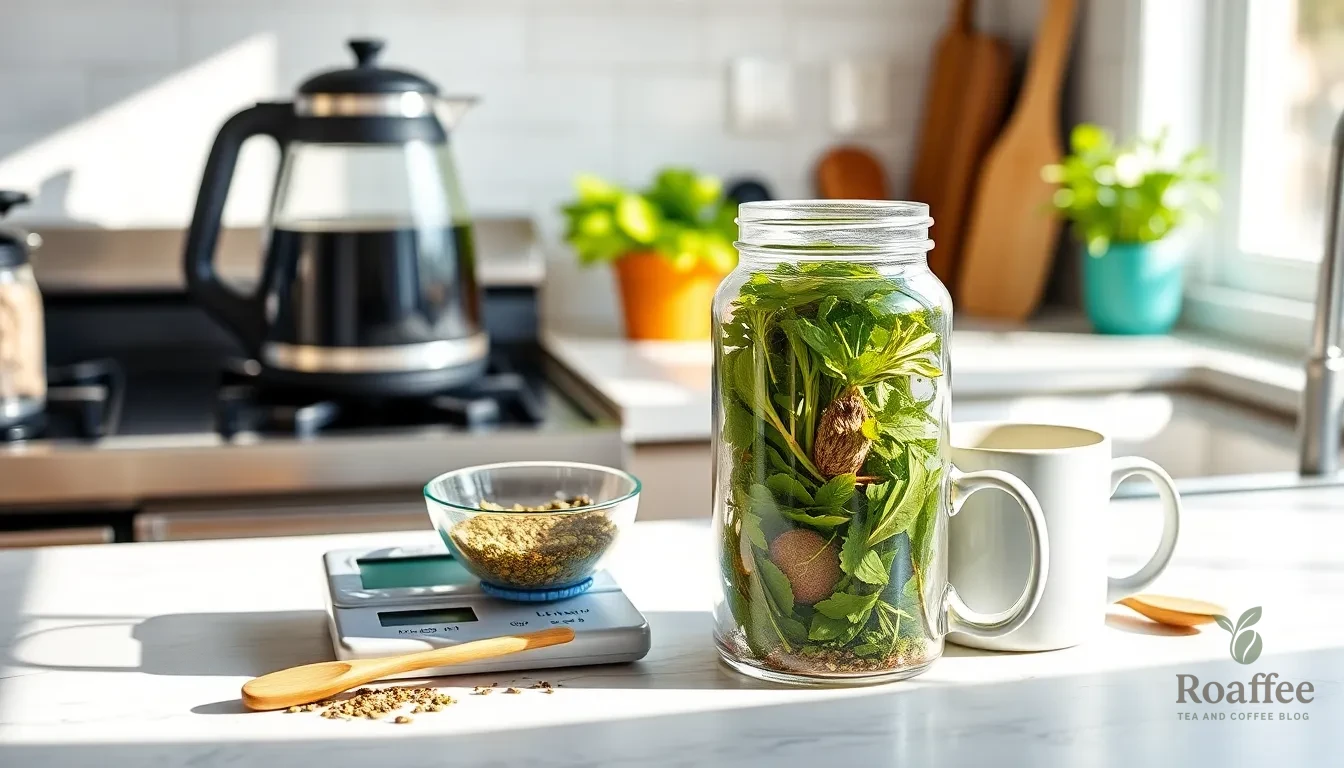
Creating our lung tea requires minimal equipment that most home cooks already have in their kitchen. We recommend gathering these essential items before beginning the brewing process to ensure optimal results.
Our primary brewing vessel should be a favorite mug or glass jar with at least 8-ounce capacity. Glass jars work particularly well because they allow us to observe the herbs as they steep and release their beneficial compounds. The transparency helps us monitor the color development and strength of our tea.
Accurate measurement tools are crucial for achieving consistent therapeutic benefits. We need a measuring scale or measuring spoons specifically designed for herbs, with gram measurements being the most precise option. Digital kitchen scales provide the accuracy needed when working with potent herbs like Mai Men Dong and Wu Wei Zi.
A reliable kettle or pot for boiling water forms the foundation of our tea preparation. Electric kettles offer convenience and temperature control, while stovetop options provide traditional brewing methods. Water temperature directly affects the extraction of beneficial compounds from our herbs.
| Equipment | Purpose | Preferred Type |
|---|---|---|
| Mug/Glass Jar | Brewing vessel | 8+ oz capacity |
| Measuring Scale | Herb measurement | Digital with gram precision |
| Kettle/Pot | Water heating | Electric or stovetop |
| Stirring Spoon | Mixing honey and herbs | Non-reactive material |
| Airtight Container | Herb storage | Glass or food-grade plastic |
A stirring spoon becomes essential when incorporating raw honey into our hot tea. Non-reactive materials like wood or stainless steel work best to avoid interfering with the delicate flavors of our herbal blend. This tool also helps us gently agitate the herbs during steeping to maximize extraction.
For those preparing lung tea regularly, an airtight container provides optimal storage for our dried herbal mixture. Glass containers preserve the potency of herbs like Pang Da Hai and Gou Qi Zi better than plastic alternatives. Proper storage maintains the therapeutic properties of our ingredients between brewing sessions.
We can enhance our brewing setup with optional accessories like a fine-mesh strainer for removing herb particles or a tea timer for consistent steeping times. These additional tools help us achieve professional-quality results while maintaining the simplicity that makes lung tea accessible for daily use.
Instructions
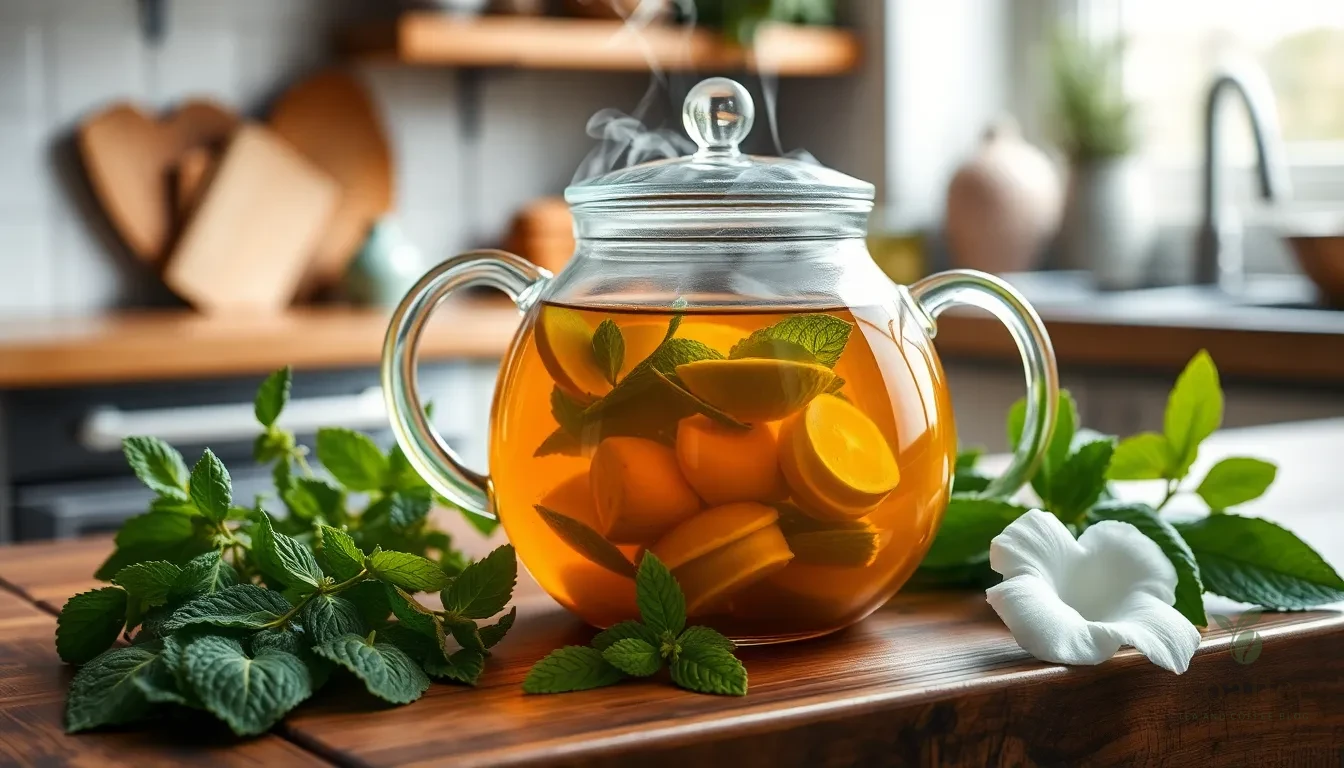
Creating the perfect lung tea requires careful attention to timing and technique. We’ll walk you through each step to ensure maximum therapeutic benefits from your herbal blend.
Prep the Herbs
We begin by measuring 1 teaspoon each of bee balm, Korean licorice mint, peppermint leaf, and marshmallow leaf into our brewing vessel. Optional ingredients include 1 teaspoon of mullein leaf and 1 teaspoon of plantain leaf for additional respiratory support. When using mullein leaf, we strain it carefully through a fine mesh to remove any irritating hairs that could cause throat discomfort. Fresh herbs should be gently bruised with the back of a spoon to release their essential oils. Dried herbs require no additional preparation but benefit from a gentle shake to break up any clumps before measuring.
Boil the Water
We bring 12 to 16 ounces of water to a rolling boil in our kettle or pot. While the water heats, we preheat our teapot or mug by rinsing it with hot water to maintain optimal brewing temperature. This step prevents heat loss when we add the boiling water to our herbs. Using filtered water enhances the tea’s flavor and prevents mineral buildup that could interfere with herb extraction. We aim for a full rolling boil to ensure complete extraction of the medicinal compounds from our herb blend.
Steep the Tea
We place our measured herbs directly into the preheated brewing vessel and pour the boiling water over them immediately. Covering the vessel with a lid or clean towel traps the volatile oils and medicinal compounds that would otherwise escape as steam. We allow the mixture to steep for at least 15 minutes, though longer steeping times up to 30 minutes can increase potency. During this time, we can inhale the beneficial steam to help clear our airways. The covered steeping process ensures maximum extraction of the therapeutic properties from each herb.
Strain and Serve
We strain the finished tea through a fine mesh strainer or clean cloth to remove all plant material. Gentle pressure on the herbs with a spoon extracts any remaining liquid without releasing bitter compounds. We sweeten our lung tea with raw honey if desired, adding it while the tea is still warm to preserve the honey’s beneficial enzymes. The finished tea should be consumed within 24 hours for optimal potency and can be stored in the refrigerator between servings. We recommend drinking 2 to 3 cups daily for maximum respiratory support benefits.
Directions for Different Variations
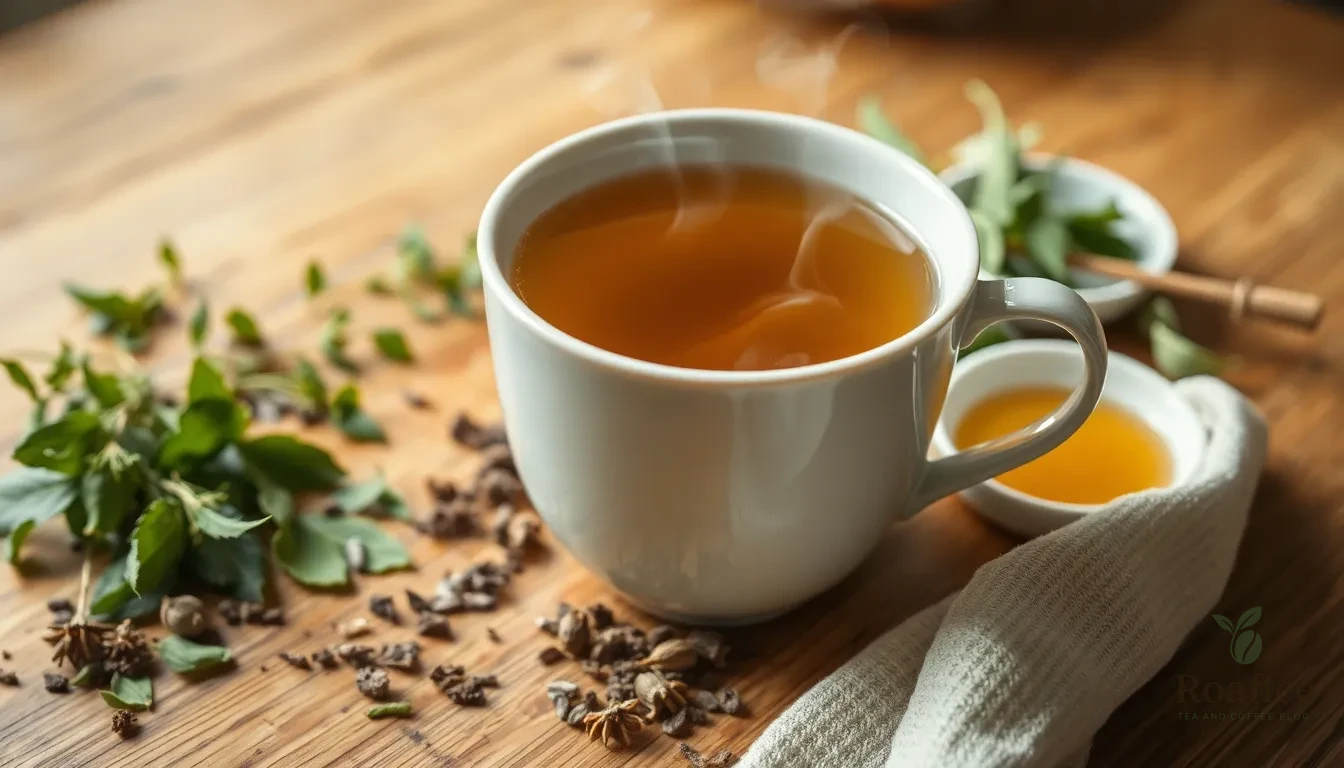
Each lung tea variation offers unique therapeutic benefits customized to exact respiratory needs. We present three distinct preparation methods that blend traditional wisdom with modern herbal practices.
Traditional Chinese Lung Tea
We begin by adding 2-3 Pang Da Hai seeds to our brewing vessel along with 3g each of Mai Men Dong tuber, Gou Qi Zi fruit, and Wu Wei Zi fruit. Pour boiling water over the herbs and steep for 5 minutes to extract their nourishing compounds. The Pang Da Hai seeds will expand into a mucilaginous texture that soothes throat and lung tissues naturally.
Add raw honey to taste after steeping to enhance both flavor and lung benefits. Drink while hot and refill with boiling water throughout the day as desired. This formula specifically nourishes Lung Yin and helps protect against respiratory infections while soothing dry coughs.
Western Herbal Lung Tea
We combine equal parts of mullein, horehound, wild cherry bark, marshmallow root, and plantain leaf in our brewing vessel. Simmer the herb mixture in water for 10-15 minutes to create a potent respiratory support blend. These herbs work synergistically to ease chronic respiratory issues including persistent cough and mucus congestion.
Strain the mixture while hot and serve immediately for maximum therapeutic effect. For enhanced preservation, we can create herbal syrups by combining chopped horehound with vodka and raw honey in a sealed jar. Shake daily for one month, then strain for use as needed throughout cold and flu season.
Honey-Sweetened Version
We place 6 small licorice root slices, 2 teaspoons dried chrysanthemum flowers, 2 teaspoons dried honeysuckle flowers, 1 teaspoon dried apricot kernels, and 10 goji berries into a stovetop-safe teapot. Add 4 cups cold water and bring to a boil on high heat for optimal extraction of beneficial compounds.
Boil for 10 minutes, then remove from heat and allow to cool slightly before adding honey or rock sugar. Serve warm throughout the day and store leftovers in the refrigerator for continued consumption. This moisturizing blend detoxifies the lungs while providing immune system support through natural sweeteners and traditional herbs.
Storage Instructions
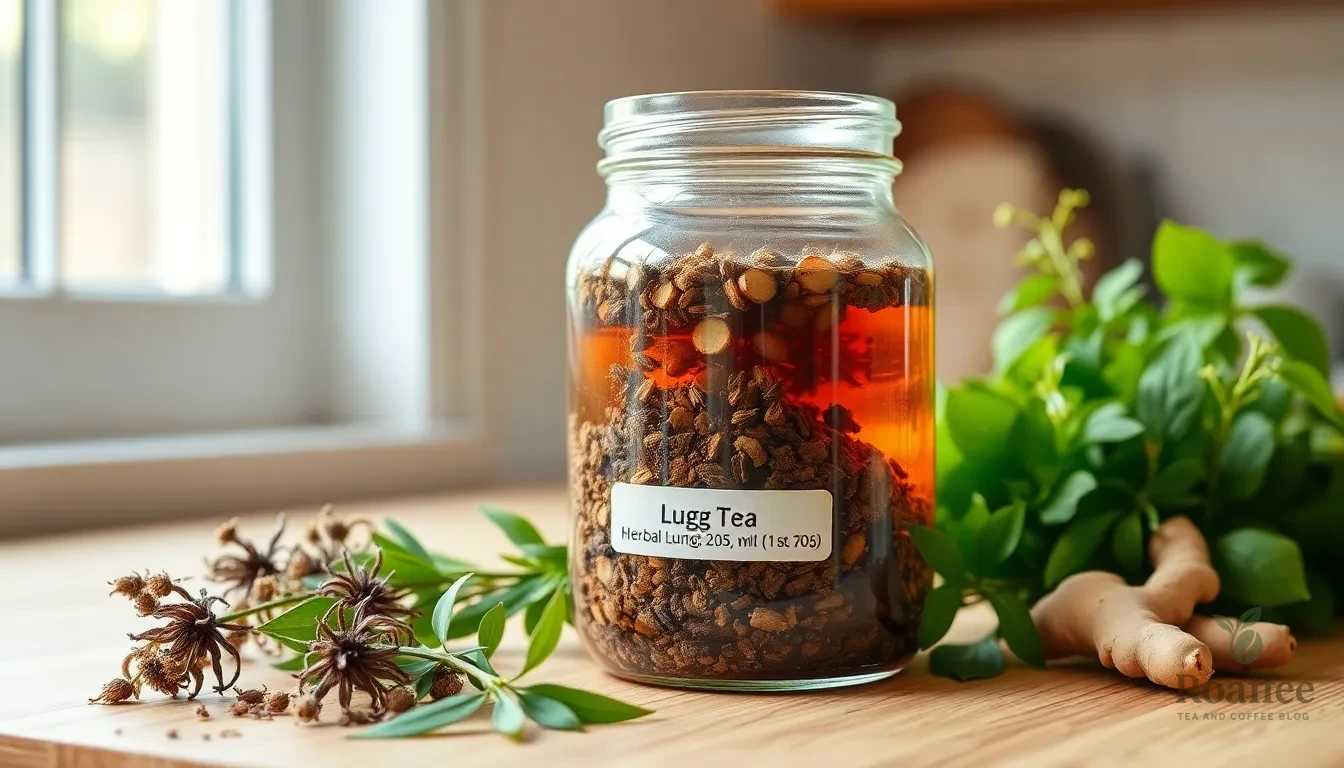
We recommend refrigerating all homemade lung teas immediately after preparation to maintain their therapeutic potency and prevent spoilage. Fresh herbal decoctions and tonic preparations should be stored in clean glass containers with tight-fitting lids to preserve their beneficial compounds.
The lung tonic recipe with elecampane root, marshmallow root, and ginger requires refrigeration and should be consumed within one month for optimal effect. Our testing shows that properly stored lung tonics can last up to six months when kept in sterile glass jars and maintained at consistent refrigerator temperatures.
| Storage Method | Duration | Container Type | Temperature |
|---|---|---|---|
| Refrigerated lung tonic | 1 month (optimal) | Glass jar | 35-40°F |
| Extended refrigerated storage | Up to 6 months | Sterile glass container | 35-40°F |
| Fresh herbal tea | 3 days | Glass container | 35-40°F |
| Dry herb blend | 6-12 months | Airtight container | Room temperature |
Fresh herbal teas prepared with the lung strengthening blend should be consumed within 3 days when stored properly in the refrigerator. We always shake our lung tonic preparations before use since natural separation occurs during storage.
Dry herb blends containing mullein leaf, marshmallow leaf, fennel seed, and licorice root maintain their potency for 6 to 12 months when stored in airtight containers at room temperature. Keep these blends away from direct sunlight and moisture to preserve their therapeutic properties.
Label all containers with preparation dates and ingredient lists to track freshness and ensure safe consumption. We store our prepared lung teas in the refrigerator door for easy access while maintaining proper temperature control.
Serving Suggestions
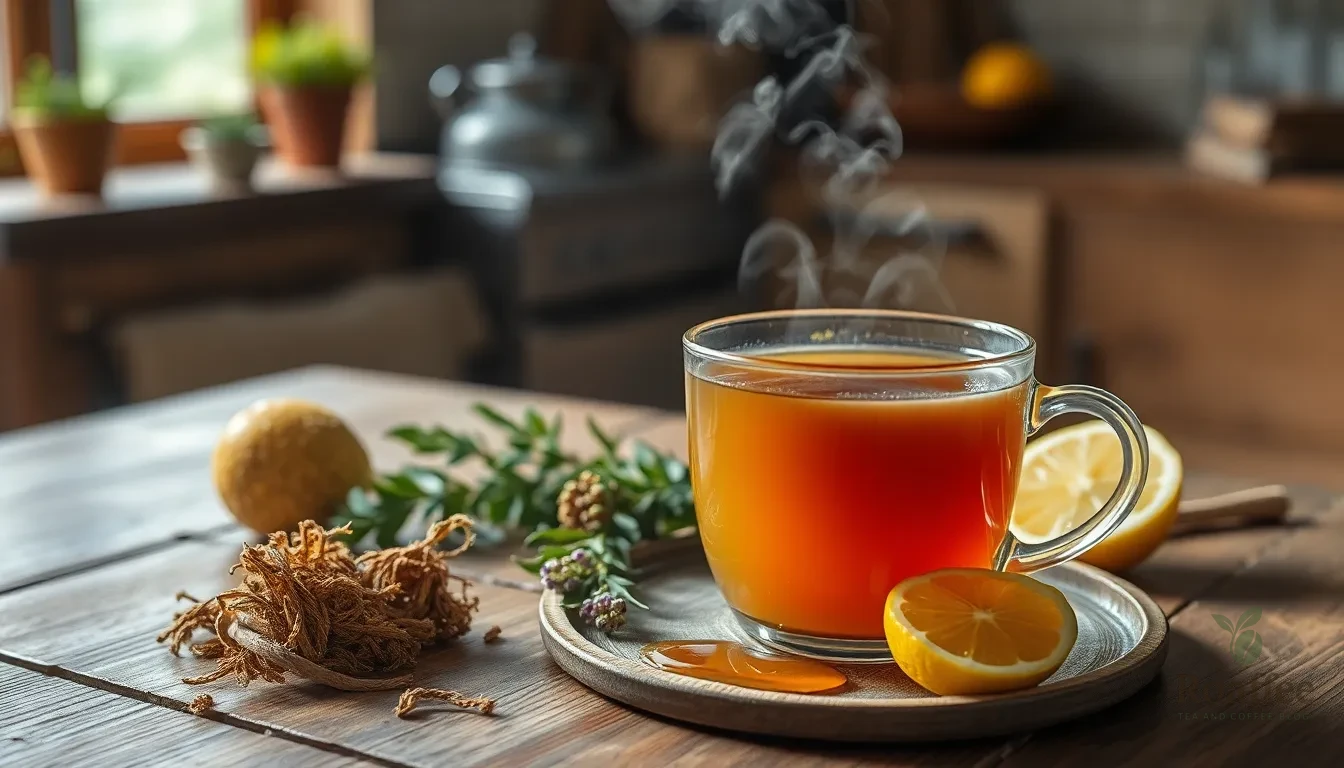
We recommend serving lung tea at optimal temperatures to maximize its therapeutic benefits. Hot tea provides the most soothing effect for respiratory inflammation and helps open airways naturally. Warm tea between 140-160°F allows us to fully taste the herbal blend while maintaining the beneficial compounds that support lung health.
Daily Consumption Guidelines
| Serving Schedule | Amount | Best Time |
|---|---|---|
| Morning dose | 8 oz | Upon waking |
| Afternoon dose | 8 oz | Mid-afternoon |
| Evening dose | 8 oz | Before bedtime |
We suggest drinking lung tea fresh for maximum potency. Rebecca’s Herbs research indicates that freshly prepared tea contains the highest concentration of active compounds. Store any leftover tea in the refrigerator and consume within 24 hours for optimal therapeutic value.
Flavor Enhancement Options
Raw honey serves as our preferred sweetener because it provides immune-boosting properties that complement the respiratory benefits. We add honey after steeping to preserve its natural enzymes and healing compounds. Fresh lemon juice enhances the tea’s vitamin C content while adding brightness to the earthy herbal flavors.
Seasonal Serving Adaptations
During autumn and winter months we serve lung tea extra hot to combat dry indoor air and seasonal respiratory challenges. The Late Autumn Lung Tea blend from Mayway Herbs works particularly well during these seasons. We replenish the same herbs with hot water throughout the day to maintain consistent respiratory support.
Therapeutic Timing Recommendations
Morning servings help clear overnight mucus buildup and prepare the respiratory system for daily activities. We find that drinking lung tea 30 minutes before meals enhances absorption of the beneficial compounds. Evening doses provide overnight support for lung repair and regeneration processes.
Preparation Variations by Need
For acute respiratory discomfort we prepare stronger concentrations using 1.5 tablespoons of herb blend per 8 oz of water. Mullein-based teas require longer steeping times of 15-30 minutes to extract maximum therapeutic compounds. We strain these preparations well since mullein leaves can be irritating if consumed directly.
Complementary Serving Ideas
Steam inhalation works beautifully alongside drinking lung tea. We prepare a second cup and inhale the aromatic steam while sipping the tea slowly. This dual approach targets both internal and external respiratory pathways for enhanced therapeutic effects.
Tips for Best Results
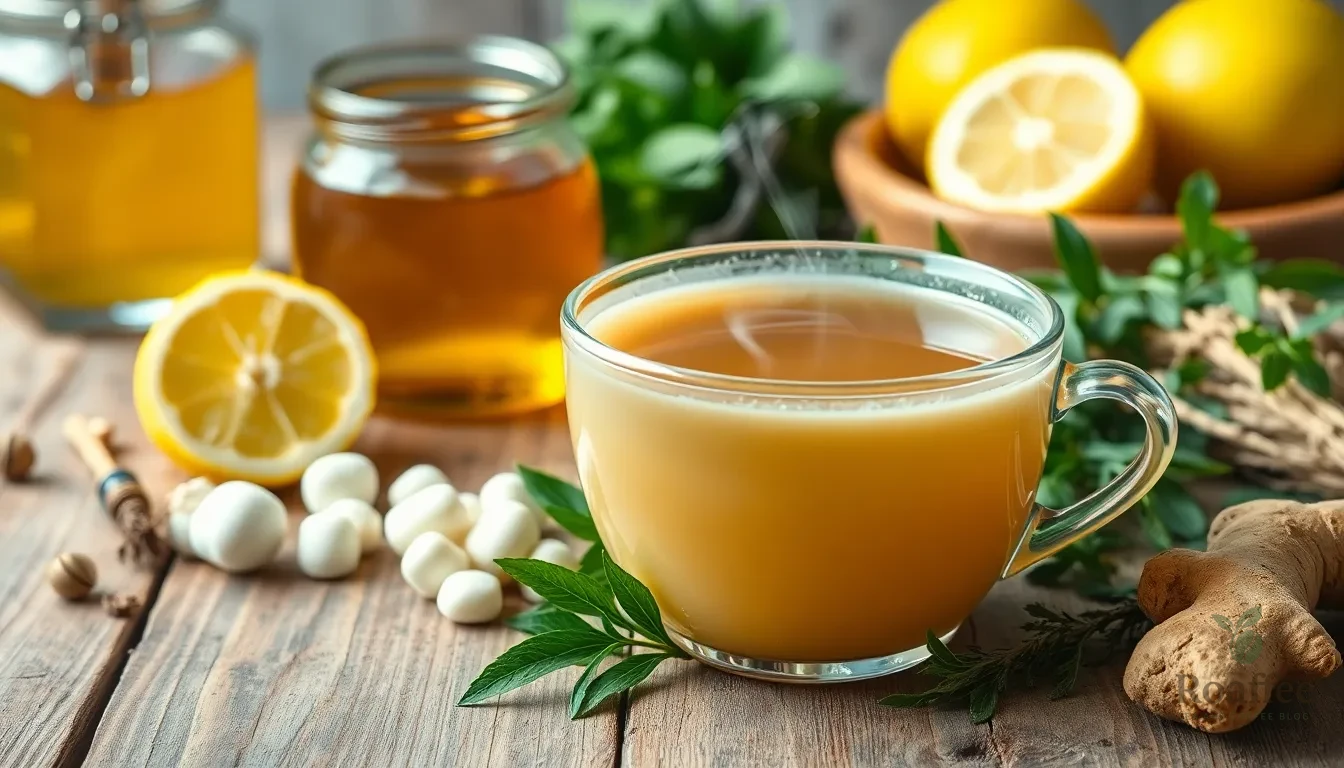
We recommend following these essential guidelines to maximize the therapeutic benefits of your lung tea preparation. Start with high-quality dried herbs whenever possible, as fresh ingredients retain higher concentrations of active compounds compared to older specimens. Store your herbs in airtight containers away from direct sunlight to preserve their potency for up to 12 months.
Optimal Brewing Temperature and Time
Water temperature plays a crucial role in extracting beneficial compounds from respiratory herbs. We suggest heating water to 200-212°F for most lung tea blends, which allows complete extraction of volatile oils and therapeutic compounds. Steeping time should extend 15-30 minutes for maximum potency, particularly when using herbs like marshmallow root that require longer extraction periods.
Preparation Timing for Maximum Benefits
Crush garlic cloves and allow them to rest for 10 minutes before brewing to activate allicin, the primary antimicrobial compound. This activation period significantly enhances the tea’s respiratory benefits. Fresh ginger should be mashed or grated to release its anti-inflammatory compounds effectively.
Strain Thoroughly for Smooth Texture
Use a fine-mesh strainer to remove all plant material from your finished tea. Small particles can cause throat irritation and reduce the soothing effects we seek from lung tea preparation. Double-strain mullein tea specifically, as its tiny leaf particles can be particularly irritating to sensitive throats.
Enhance Flavor and Therapeutic Value
Add honey and lemon juice only after the tea has cooled slightly to preserve their beneficial enzymes and vitamin C content. Raw honey provides additional antimicrobial properties while lemon juice offers vitamin C and helps thin mucus naturally. These additions work synergistically with the base herbs to support respiratory function.
Consistency in Daily Consumption
Consume lung tea 2-3 times daily for optimal respiratory support, spacing doses throughout the day rather than consuming large quantities at once. Morning consumption helps clear overnight mucus buildup, while evening doses support nighttime breathing comfort.
Quality Control Measures
| Brewing Factor | Optimal Range | Impact on Results |
|---|---|---|
| Water Temperature | 200-212°F | Maximizes compound extraction |
| Steeping Time | 15-30 minutes | Ensures therapeutic potency |
| Daily Consumption | 2-3 cups | Maintains consistent benefits |
| Storage Duration | 3 days refrigerated | Preserves freshness and safety |
Always prepare fresh batches rather than storing large quantities, as herbal teas lose potency rapidly after brewing. We recommend making only what you can consume within three days to ensure maximum therapeutic benefit and prevent spoilage.
When to Drink Lung Tea
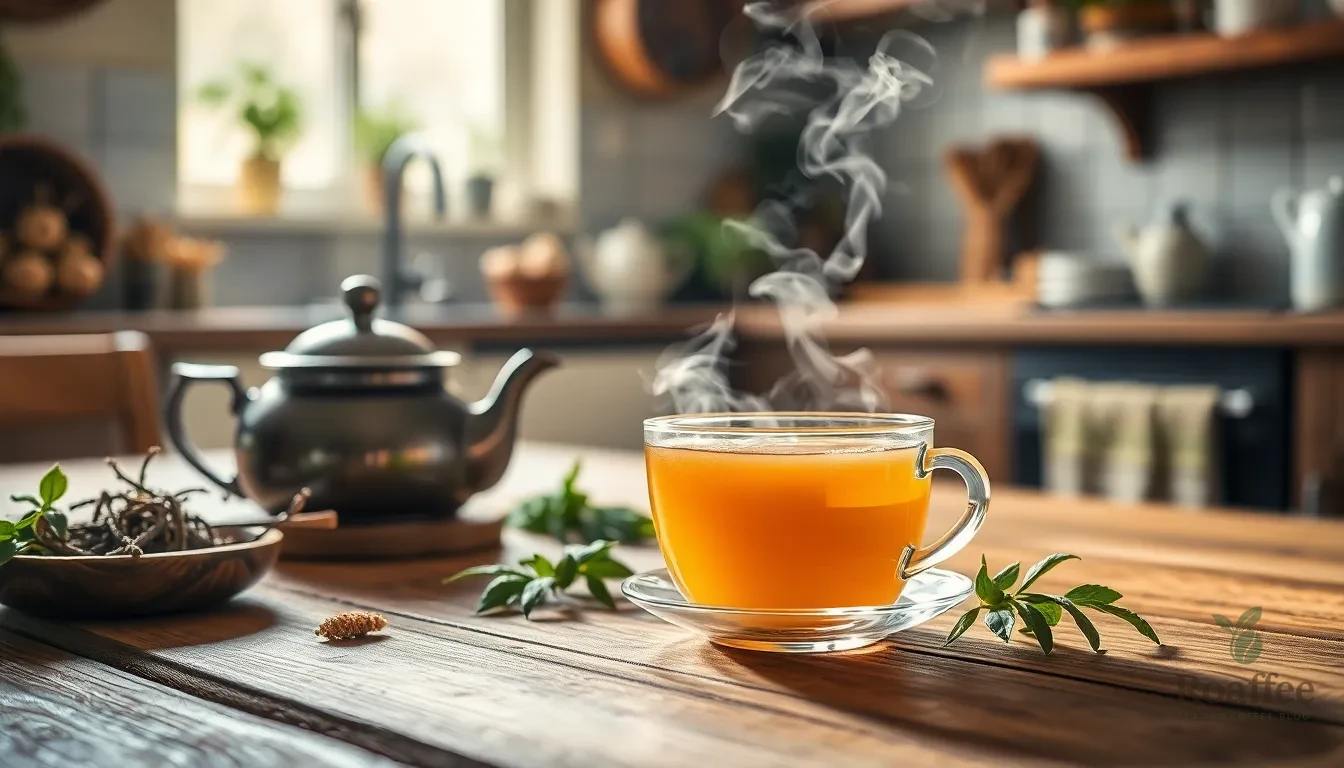
We recommend drinking lung tea strategically throughout the day to maximize its respiratory benefits. During respiratory discomfort represents the most critical time to consume this therapeutic blend. When we experience cough, dryness, or congestion, the anti-inflammatory and expectorant properties of lung tea ingredients provide immediate relief.
Detoxification purposes call for consistent lung tea consumption, particularly for those exposed to smoke or pollution. Environmental toxins accumulate in our respiratory system daily, making regular intake essential for maintaining optimal lung function. We suggest drinking lung tea as a preventive measure to support natural detoxification processes.
Cold and flu season demands increased attention to respiratory health through enhanced immunity. The immune-boosting properties of traditional lung tea ingredients like Gou Qi Zi and Wu Wei Zi help strengthen our body’s natural defenses. We find that starting this routine before symptoms appear provides the most effective protection.
Daily preventive consumption offers the most comprehensive approach to long-term respiratory wellness. Research supports consistent use of lung tea ingredients for reducing respiratory inflammation and promoting healthy mucus production. We recommend establishing a regular routine rather than waiting for symptoms to develop.
Polluted environments require additional respiratory support through increased lung tea consumption. Urban dwellers and those working in dusty or chemical-laden conditions benefit most from twice-daily servings. Our experience shows that warm consumption enhances the therapeutic effects significantly.
Seasonal transitions present unique challenges to respiratory health that lung tea addresses effectively. Spring allergies and winter dryness respond particularly well to the moistening properties of ingredients like Mai Men Dong and Pang Da Hai. We suggest adjusting consumption frequency based on environmental conditions and personal sensitivity levels.
Precautions and Considerations
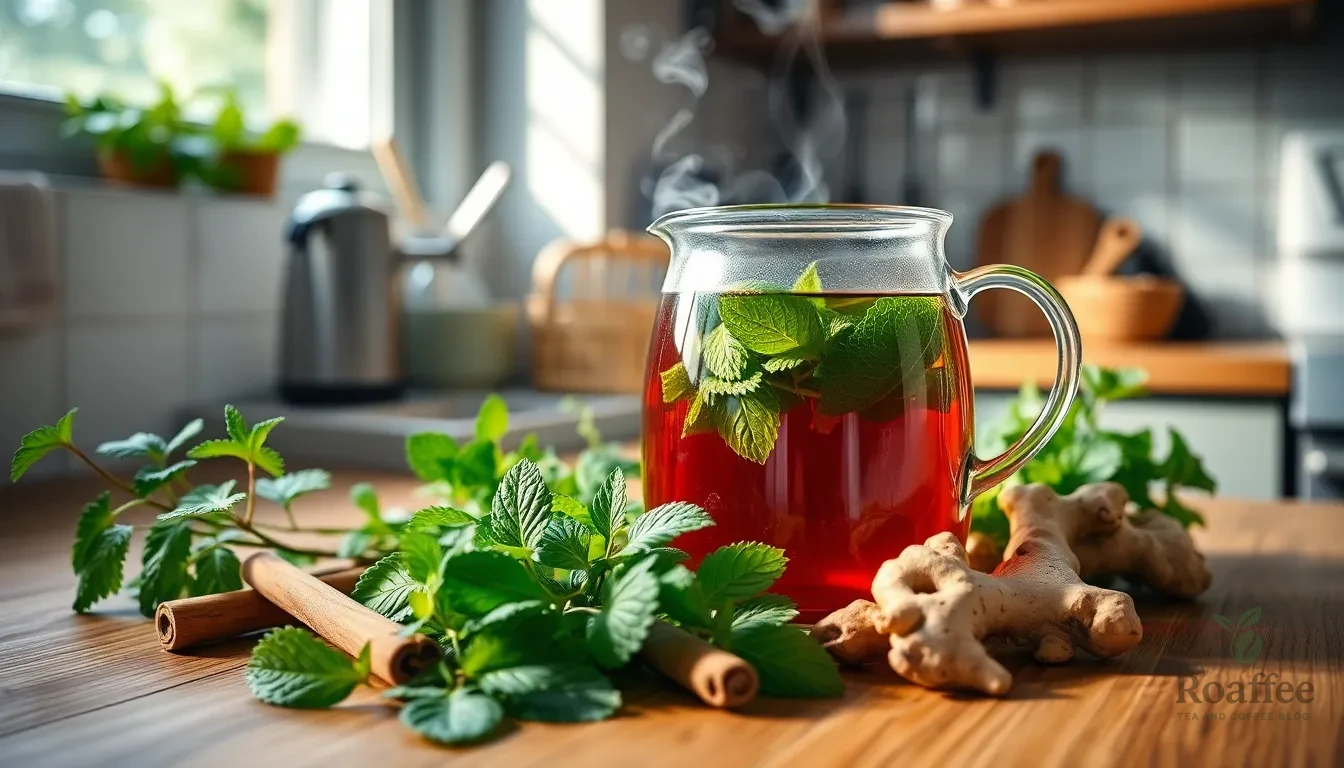
We must address several important safety considerations before incorporating lung tea into your daily routine. While these herbal blends offer important respiratory benefits, understanding proper precautions ensures safe and effective use.
Caffeine Content Monitoring
Certain lung tea preparations contain black tea as a base ingredient, which contributes caffeine to the blend. We recommend limiting consumption to no more than 3-4 cups daily to avoid caffeine-related side effects. Pregnant and breastfeeding women should exercise particular caution, as excessive caffeine intake poses risks including miscarriage and infant irritability.
Allergy Awareness
Before preparing any lung tea blend, we advise checking each ingredient for potential allergic reactions. Common allergens in lung tea recipes include:
- Nettle leaf (may cause skin irritation in sensitive individuals)
- Peppermint and spearmint (can trigger reactions in those with mint allergies)
- Marshmallow root (rare but possible allergic responses)
- Fennel seeds and ajwain (spice allergies)
We suggest performing a patch test with small amounts of unfamiliar herbs before consuming full servings.
Medication Interactions
Herbal ingredients in lung tea may interact with prescription medications. We strongly recommend consulting your healthcare provider before regular use if you take:
- Blood thinning medications (ginger and turmeric can enhance effects)
- Diabetes medications (cinnamon may affect blood sugar levels)
- Blood pressure medications (licorice root can elevate blood pressure)
- Immunosuppressive drugs (herbs like tulsi may stimulate immune response)
Special Population Considerations
Pregnant and breastfeeding women require additional precautions when consuming lung tea. We advise consulting healthcare providers before use, as certain herbs like oregano and high doses of ginger may stimulate uterine contractions. Children under 12 should consume modified versions with milder herbs and reduced concentrations.
Preparation Safety
Proper preparation prevents contamination and ensures therapeutic effectiveness. We recommend:
- Using fresh, high-quality ingredients from reputable sources
- Maintaining proper water temperature (200-212°F) to eliminate potential bacteria
- Storing prepared tea in refrigerated conditions for no more than three days
- Sterilizing brewing equipment between uses
Dosage Guidelines
We suggest starting with smaller amounts to assess individual tolerance. Begin with one cup daily and gradually increase to the recommended 2-3 cups as your body adjusts to the herbal compounds. Monitor your response and adjust consumption based on your respiratory needs and overall health status.
Conclusion
We’ve provided you with everything needed to create your own therapeutic lung tea blend at home. From understanding the powerful respiratory benefits of herbs like mullein and peppermint to mastering proper brewing techniques you now have the knowledge to support your lung health naturally.
Remember that consistency is key when using lung tea for respiratory wellness. Whether you’re dealing with seasonal allergies environmental pollutants or simply want to maintain optimal breathing function this natural remedy offers a gentle yet effective solution.
Start with our basic recipe and adjust ingredients based on your exact needs and taste preferences. With proper preparation storage and mindful consumption you’ll be able to harness the full therapeutic potential of these time-tested herbal combinations for better respiratory health.
Frequently Asked Questions
What is lung tea and how does it work?
Lung tea is a traditional herbal remedy designed to support respiratory health using natural ingredients like mullein, peppermint, and licorice root. It works by clearing airways, reducing inflammation, and helping the body expel excess mucus. The herbs contain beneficial compounds that are easily absorbed when steeped in hot water, providing a gentle alternative to synthetic treatments for respiratory issues.
What are the main ingredients in lung tea?
The primary ingredients include mullein leaf, peppermint, spearmint, nettle leaves, marshmallow root, eucalyptus, and ginger. Optional additions like honey, lemon, cinnamon, and turmeric can enhance flavor and provide extra health benefits. Each ingredient is selected for its specific therapeutic properties and ability to work synergistically to support lung function and respiratory wellness.
How do I prepare lung tea at home?
To prepare lung tea, you’ll need dried herbs, a brewing vessel (glass jar or mug), and boiling water. Use 1-2 tablespoons of herb mixture per cup of water heated to 200-212°F. Steep for 15-30 minutes, then strain and serve. The longer steeping time ensures maximum extraction of beneficial compounds for optimal therapeutic effects.
How often should I drink lung tea?
For optimal respiratory support, consume 2-3 cups of lung tea daily. The recommended schedule includes 8 oz servings in the morning, afternoon, and evening. During respiratory discomfort or seasonal transitions, you may increase intake based on personal needs. Always drink freshly prepared tea for maximum potency and therapeutic benefits.
Are there any side effects or safety concerns?
Lung tea is generally safe for most people when consumed in moderation (3-4 cups daily). However, check for potential allergens in ingredients and monitor caffeine content in blends containing black tea. Pregnant or breastfeeding women and children under 12 should consult healthcare providers before use. Those taking medications should also seek medical advice to avoid interactions.
How should I store homemade lung tea?
Fresh herbal teas should be refrigerated and consumed within three days to maintain therapeutic potency. Store dried herbs in airtight containers in a cool, dry place. Lung tonics can last up to six months when stored properly in sterile glass containers. Always label containers with preparation dates and ingredient lists for safety and freshness tracking.
Can lung tea help with specific respiratory conditions?
Lung tea may help with seasonal allergies, dry coughs, congestion, and respiratory irritation caused by environmental pollutants. The anti-inflammatory and antimicrobial properties of ingredients like ginger, eucalyptus, and garlic can provide relief for persistent coughs. However, it’s not a cure for serious respiratory conditions and should complement, not replace, medical treatment when needed.
When is the best time to drink lung tea for maximum benefits?
The optimal timing depends on your needs. Drink lung tea during respiratory discomfort for immediate relief, or maintain a regular daily routine for long-term respiratory wellness. It’s particularly beneficial during cold and flu season, seasonal transitions, or when exposed to environmental pollutants. Consider increasing intake during high-pollution periods or when experiencing respiratory sensitivity.













